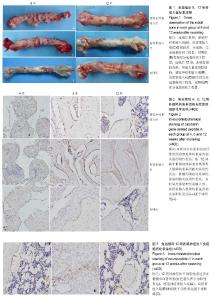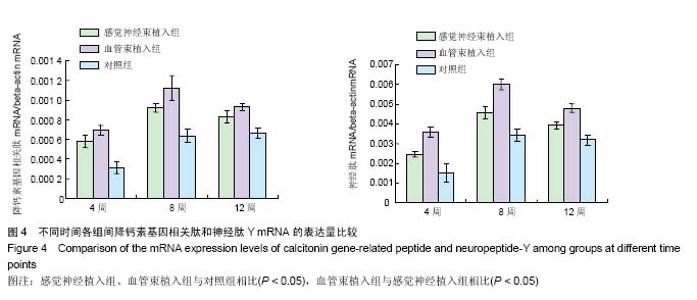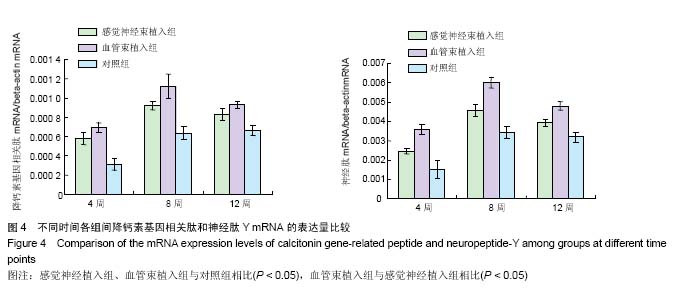| [1] Poyner D, Marshall I, Brain SD. The CRRP Family. 1st eds. Landes Bioscience USA Texas.1999: 173-252.[2] Irie K,Hara-Irie F,Ozawa H,et al.Calcitonin gene-related peptide (CGRP)-containing nerve fibers in bone tissue and their involvement in bone remodeling. Microsc Rea Tech.2002; 58(2): 85-90.[3] Livak KJ,Schmittgen TD.Analysis of relative gene expression data using real-time quantitative PCR and the 2-△△CT method. Methods.2001;25(4):402-408.[4] Bjurholm A.Neuroendocrine peptides in bone. Int Orthop.1991; 15(4): 325-329.[5] Bjurholm A, Kreicbergs A, Brodin E, et al. Substance P- and CGRP- immunoreactive nerves in bone. Peptides.1988; 9(1): 165-171.[6] Hohmann EL, Elde RP, Rysavy JA,et al.Innervation of periosteum and bone by sympathetic vasoactive intestinal peptide-containing nerve fibers. Science.1986; 232 (4752): 868-871.[7] Hill EL, Elde R. Distribution of CGRP-, VIP-, DβH-, SP-, and NPY-immunoreactive nerves in the periosteum of the rat. Cell Tissue Res.1991;264(3):469-480.[8] Madsen JE, Hukkanen M ,Aune AK, et al. Fracture healing and callus innervation after peripheral nerve resection in rats. Clin orthop.1998;351(351): 230-240.[9] Hukkanen M , Konttinen YT, Santavirta S, et al. Effect of sciatic nerve section on neural ingrowth into the rat tibial fracture callus. Clin Orthop.1995; 311(311): 247-257.[10] 张元平,崔继秀,裴国献,等.神经化组织工程骨构建的初步观察[J].中华创伤骨科杂志,2005,7(1):55-56.[11] Masaki K. Enhancement of rat peripheral nerve regeneration through artegcontaining silicone tubing.Exp Neurol.1990; 107(1): 69-69.[12] 张爱华,朱家恺.血管植入变性骨骼肌修复神经缺损实验研究[J].中华显微外科杂志,1990, 13(1):25-28.[13] Peng W, Wang L, Zhang J, et al. A novel tissue-engineered bone in repairing femoral head defect and necrosis. Int J Clin Exp Med.2015;8(1): 1087-1093.[14] Hukkanen M, Konttinen YT, Santavirta S, et al. Rapid proliferation of calcitonin gene-related peptide-immunoreactive nerves during healing of rat tibial fracture suggests neural involvement in bone growthand remodeling. Neuroscience.1993; 54(4): 969-979.[15] Zhang C, Ma J, Li M, et al. Repair effect of coexpression of the hVEGF and hBMP genes via an adeno-associated virus vector in a rabbit model of early steroid-induced avascular necrosis of the femoral head. Transl Res.2015;166(3):269-280.[16] Onuoha GN. Circulating sensory peptide levels within 24 h of human bone fracture. Peptides.2001;22(7): 1107-1110.[17] Shi D,Sun Y,Yin J,et al.Cajan leaf combined with bone marrow-derived mesenchymal stem cells for the treatment of osteonecrosis of the femoral head. Exp Thermed.2014;7(6): 1471-1475.[18] Guenther D, Schmidl S, Klatte TO, et al. Overweight and obesity in hip and knee arthroplasty: Evaluation of 6078 cases. World J Orthop.2015;6(1): 137-144.[19] Aoki M,Tamai K,Saotome K.Substance P and calcitonin gene-related peptide- immunofluorescent nerves in the repair of experimental bone defects. Int Orthop. 1994; 18(5): 317-324.[20] Onuoha GN. Circulating sensory peptide levels within 24 h of human bone fracture. Peptides.2001; 22(7): 1107-1110.[21] Hossain FS, Konan S, Patel S, et al. The assessment of outcome after total knee arthroplasty: are we there yet. Bone Joint J.2015;97(1): 3-9. |



